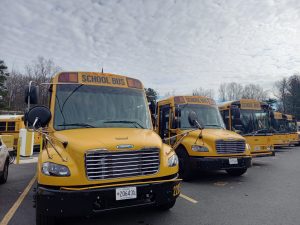As cities and towns across Montgomery County brace for winter, parents find themselves concerned the county’s school district may not be prepared to navigate an academic year that is predicted to be marked by abnormally high levels of snowfall.
A lack of winter-resistant infrastructure, poor coordination between local public works departments, and an abundantly cautious school cancellation policy loom over Montgomery County, as meteorologists forecast up to 40 inches of snow this winter – roughly twice the state average.
Predictions include between 22-30 inches of precipitation in southeast Montgomery County and 30-40 inches in the northwest, according to meteorologist Doug Kammerer.

Among the most visible byproducts of winter storms are school cancellations and delays, which hit Montgomery County particularly hard due to the structure of its education system.
Montgomery County, despite its status as the most populous county in Maryland and covering a land area of 497 square miles, is home to one continuous school district, serving close to 160,000 children in both urban population centers near Washington, D.C. and rural communities near Fredrick County.
The result is a network of municipalities with vastly different needs and environments held together under the same umbrella organization, which can lead to issues facing one region of the county rippling across the entire district.
Northern Montgomery County, for instance, is characterized by more mountainous terrain, leaving it susceptible to snowstorms, and requiring greater efforts to clear roads for school buses.
Southern Montgomery County, meanwhile, is home to lower-lying and more developed terrain, leaving it less vulnerable to the potentially hazardous consequences snow-covered roads.
Yet, due to its unified district structure, parents said a school delay or cancellation in one section of Montgomery County applies to all schools, regardless of geography or snowfall levels.
“Our experience was that if there was an expectation of two or three inches of snow up into the northern part of the county, they took the whole thing down,” said Chris Rutledge, a former parent of a Montgomery County School District student. “We would be sitting there staring at our green soggy perhaps, but still green lawn because we got nothing.”
Montgomery County Public Schools operate through a color-coded system determining school closures and delays. Calls for early dismissals are scheduled to be made by 11 a.m., while two-hour delay calls are intended to be made by 5 a.m.
Rutledge said he grew frustrated as a father, viewing the policy as a detriment to both learning outcomes for a majority of students and a burden on working parents.
“There are so many working parents, and I accept that MCPS is not there to be a babysitter,” Rutledge said. “But, you can’t say to parents, when there’s nothing on the ground, that ‘you have to take a day off of work’ and be with your kids, because we decided to close down because there’s one icy road.”
The effects of the Montgomery County approach to school closures are exasperated, by a tendency on the part of the school district to cancel school relatively quickly, even as predicted snowfall totals appear to be low in affected areas, Rutledge said.
“At a certain point, when it’s just half an inch of watery slush on the ground [and] that thousands of people seem to get to work every day, and that somehow we can’t pull this off in Montgomery County?” Rutledge said.

At the crux of the Montgomery County winter weather protocol may lie concerns regarding the capacity of smaller, northern towns to handle snowstorms.
Parks and Streets Department Director Preston King of Poolesville said the town braces for snowstorms each year due to its geography, but said he often relies on outside contractors and local residents to assist with snow removal due to a lack of resources.
“We hire contractors, and most contractors have one to two vehicles that we’re bringing in to assist the town staff.” King said. “We’re an ag community, and so where we’re located, I have several farmers that I can have do an emergency contract, and they got giant equipment to help move the snow.”
South of Poolesville, Rockville Operations and Management Assistant Superintendent Bob Valentine expressed optimism regarding his city’s ability to negate the worst effects of a snowstorm, but he said he also relied on outside groups to plow snow from roads, along with several additional cities and towns.
“We have a couple of salt contracts in place, and we have contracts for some contractors if we need them.” Valentine said. “I think when you get inundated and hammered and there’s a blizzard all the municipalities need to reach out.”
To current and former parents such as Rutledge, the salt and snowplow resource gap shows an apparent disinterest in addressing school cancellation frequency by county government.
Rutledge said he believes the school district and county government have not, in his view, taken concrete steps to search for a countywide approach to clear roads and keep schools open.
“I can’t believe that we can’t figure out how to get kids to school,” Rutledge said. “There’s less infrastructure in the county to handle snowfall, to which I respond, it snows nearly every year.”
Montgomery County Public Schools and the County Council Education Committee declined requests for comment.















Add comment